Key takeaways
- Understanding ballot measures involves recognizing their types and potential community impacts, while engaging with local discussions enhances informed voting.
- Reliable research sources, including official state websites and nonpartisan organizations, are crucial for understanding ballot measures thoroughly.
- Engaging with community perspectives fosters deeper connections and critical discussions about the implications of ballot measures.
- Effective research strategies include visiting official sources, seeking unbiased reviews, and tracking campaign funding to understand potential biases.

Understanding Louisiana ballot measures
Understanding Louisiana ballot measures can feel overwhelming at first, but it’s important to break them down into manageable parts. I remember the first time I encountered one—I was unsure what it all meant. I found that focusing on the specifics of each measure, like their potential impact on my community, helped clarify my understanding and strengthened my ability to make informed decisions.
Here are some key points to consider when exploring Louisiana ballot measures:
- What are Ballot Measures? They are proposed laws or amendments that voters decide on during elections.
- Types of Measures: These can include constitutional amendments, propositions, or referendums.
- Research Sources: I found local news articles, government websites, and community forums to be invaluable for unbiased information.
- Voter Impact: Consider how each measure affects various aspects of life, from education funding to infrastructure improvements.
- Community Voices: Listening to local leaders and attending town hall meetings provided me with different perspectives and made the issues feel more relevant.
Engaging with these resources not only informed my vote but also made me feel more connected to the democratic process in Louisiana.
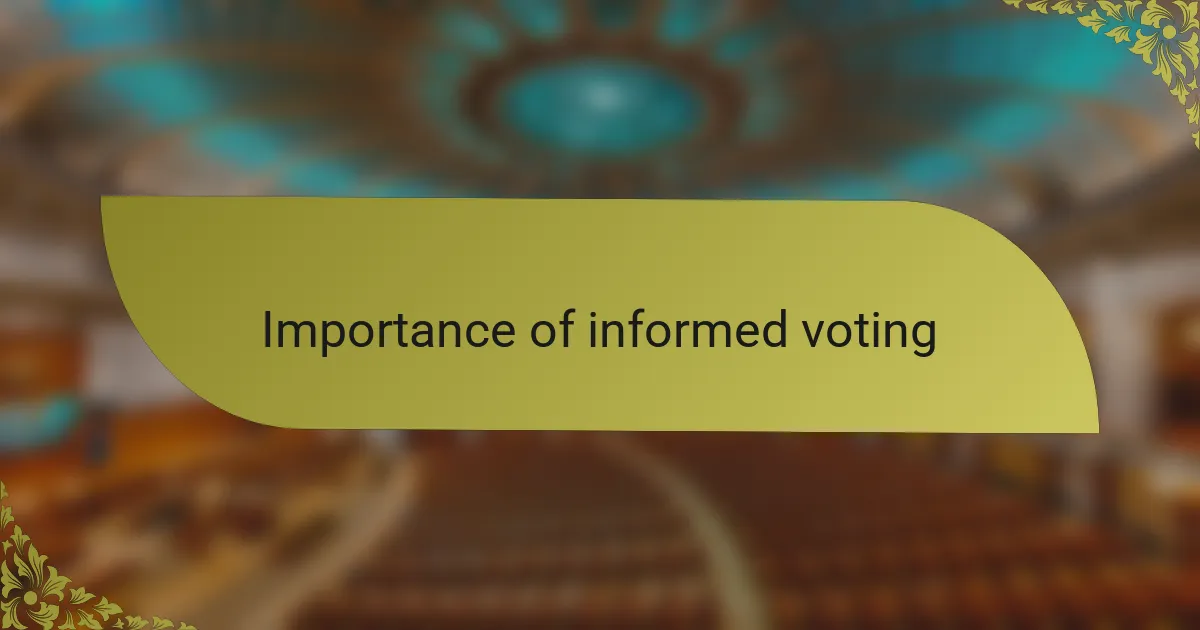
Importance of informed voting
Understanding the importance of informed voting cannot be overstated. I remember the anxiety I felt during the last election season when I realized many friends were casting ballots without fully grasping the ballot measures. It’s not just about choosing candidates; it’s about making decisions that impact our lives, communities, and futures.
When voters are informed, it leads to more thoughtful choices and a stronger democracy. I found that diving deep into each ballot measure not only clarified my own views but also sparked meaningful discussions with friends and family. Engaging in this process made me feel empowered and connected to my community.
Here’s why being an informed voter is crucial:
- It encourages critical thinking about issues that affect daily life.
- Informed voters can more effectively advocate for their communities.
- It helps hold elected officials accountable for their promises.
- Understanding ballot measures demystifies the political process, fostering greater participation.
- Knowledge of measures promotes civic responsibility and encourages dialogue among citizens.
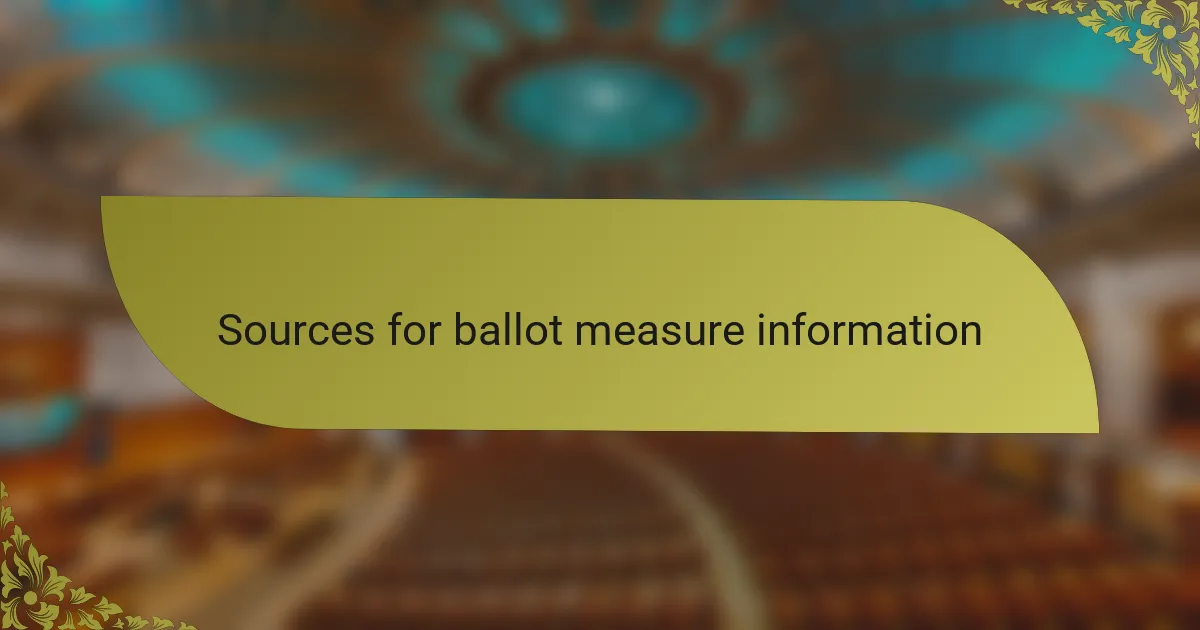
Sources for ballot measure information
When it comes to ballot measures, I’ve always believed that reliable information is key to making informed decisions. I often start with official state websites, like the Louisiana Secretary of State’s page, because they provide accurate and direct information about upcoming measures. The feeling of pulling information straight from the source offers me a sense of security—I know I’m getting the facts without distortion.
In addition to official resources, I explore local news outlets and independent fact-checking organizations. I find these sources invaluable for understanding the different perspectives surrounding each measure. For example, I remember reading a great piece from a local newspaper that broke down the implications of a contentious voting measure last election season. It was a mix of comprehensive analysis and accessible language that helped clarify complex issues.
Here’s a list of helpful sources where you can find ballot measure information:
- Louisiana Secretary of State’s website
- Local news websites and newspapers
- Nonpartisan organizations like Ballotpedia
- State and local advocacy groups
- Community forums or town hall meetings
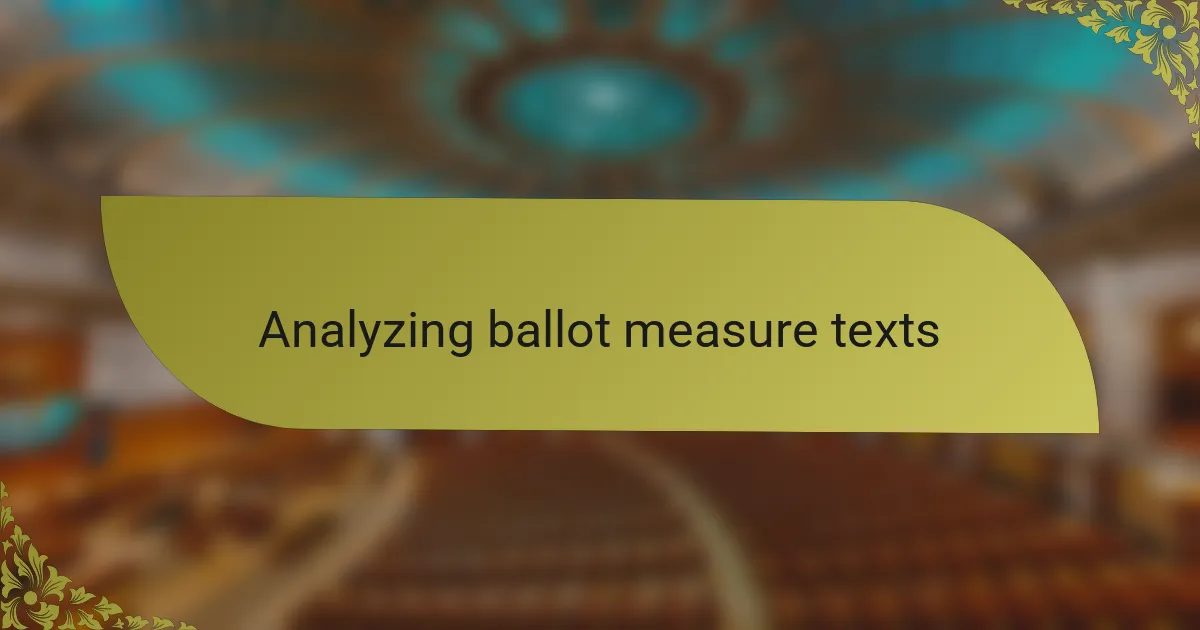
Analyzing ballot measure texts
When I first tackled the texts of ballot measures, I found myself immersed in a world of language that was both bureaucratic and intriguing. It reminded me of deciphering a puzzle, where each sentence held the potential to impact my community. I approached these texts not just as legal jargon but as important documents that could shape Louisiana’s future, and that realization made the reading experience all the more personal.
I often took notes while reading the measures, highlighting key phrases that stood out to me. I discovered that dissecting the language helped clarify the intent behind each proposition. Here’s a quick list of strategies I found helpful in my analysis:
- Look for definitions: Many measures contain specific definitions that clarify terms, which can alter the meaning of the text.
- Identify the impact: I always ask myself who will be affected by the measure—this personal angle is critical.
- Read summary statements: Often, measures have a summary section that distills complex information into digestible parts.
- Consider the source: Always check who sponsored the measure; understanding their motivations can provide insight into the measure’s potential consequences.
Engaging with the text this way not only informed my vote but also connected me deeply with the legislative process.
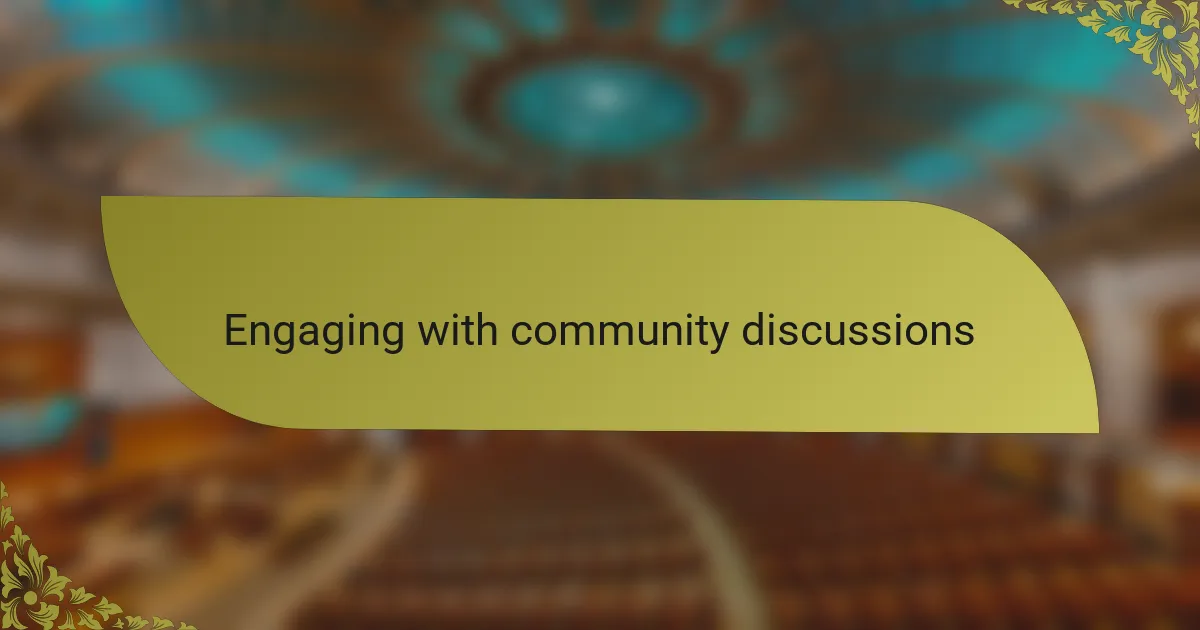
Engaging with community discussions
When I started to engage with community discussions about ballot measures, I found that local coffee shops and civic centers were excellent venues. I remember attending a town hall meeting where passionate citizens shared their thoughts. Listening to diverse perspectives opened my eyes to the nuances of each measure and how they impacted different groups in our community.
Additionally, online forums and social media platforms became invaluable resources. By participating in these digital discussions, I not only gained insight from others but also felt a sense of camaraderie. It’s truly rewarding to connect with people who care about our community’s future as much as I do.
| Engagement Method | Benefits |
|---|---|
| Town Hall Meetings | Face-to-face interaction, personal stories |
| Online Forums | Wider reach, diverse opinions |
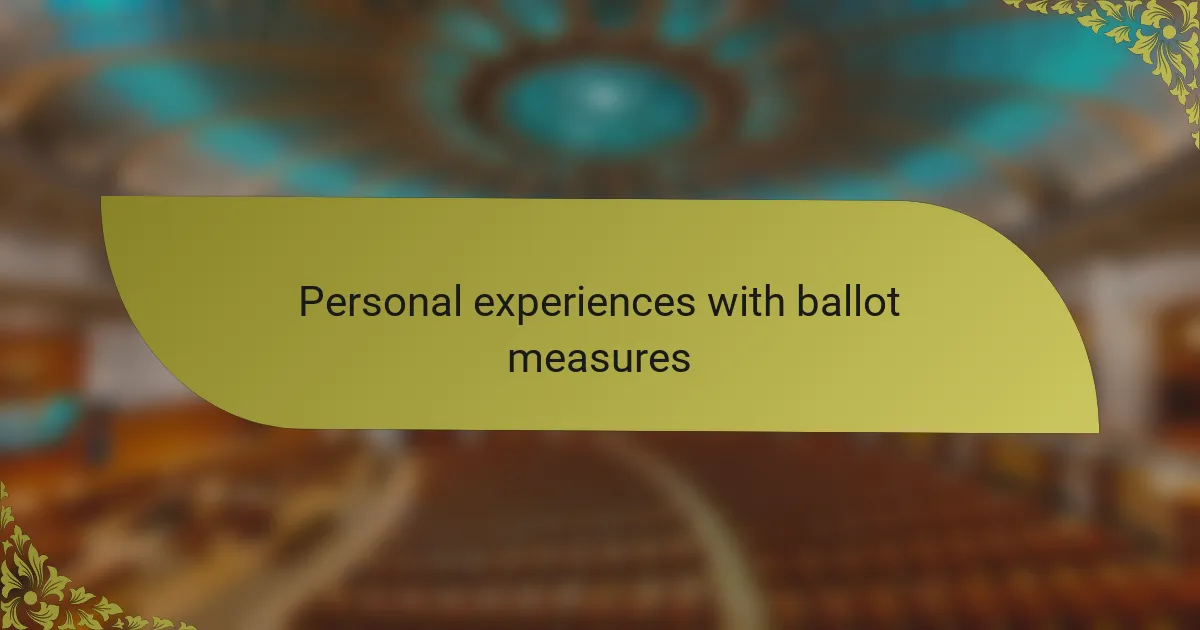
Personal experiences with ballot measures
I vividly recall my first experience voting on a ballot measure; the mix of excitement and apprehension was palpable. I had done my homework, reviewing every detail, but standing in that booth, I still felt a rush of uncertainty. It was a moment that taught me the weight of my choices. Knowing that my vote could directly influence my community made the process feel deeply personal.
In the heat of the last election, I sat down with friends to dissect the ballot measures together. It’s incredible how a shared discussion can clarify confusion. One friend had insights into a measure related to education funding that I hadn’t considered. Engaging in those conversations not only expanded my understanding but also created a bond. I could feel the collective responsibility that we all shared towards making informed decisions.
Reflecting on my experiences, I see how community interactions have shaped my views on ballot measures. Whether it was the local leader’s passionate speech at a gathering or a neighbor sharing their concerns over coffee, these moments made the implications of each measure feel immediate and real. Have you ever felt that sense of urgency in a discussion? It’s these connections that transform abstract issues into relatable challenges, reinforcing the importance of informed voting.
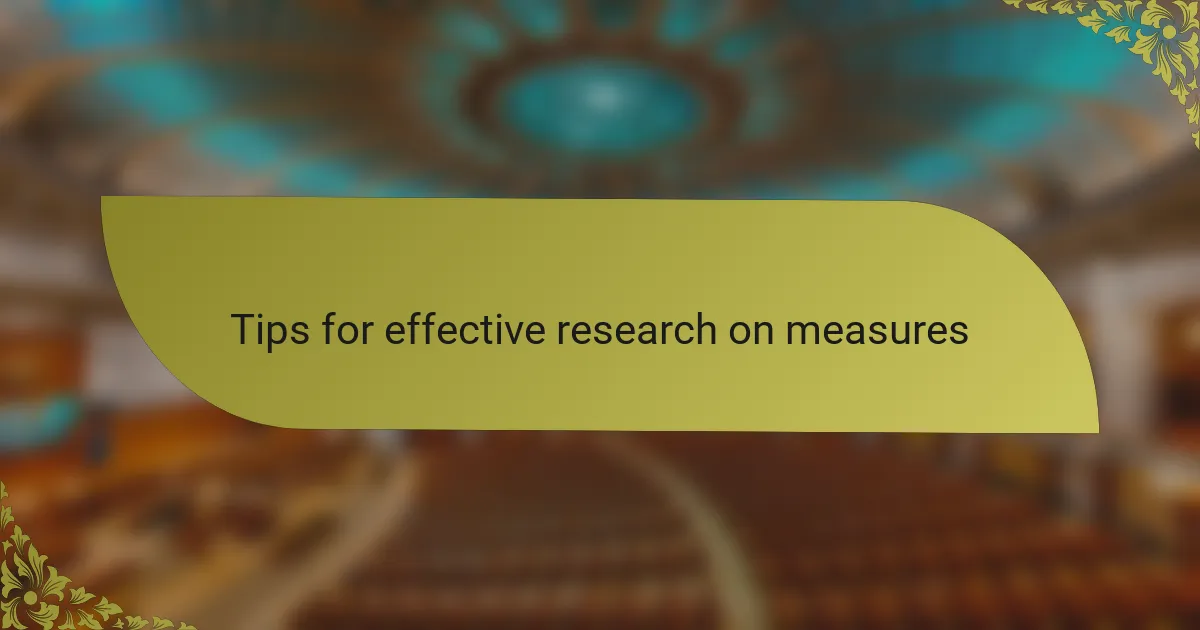
Tips for effective research on measures
When tackling ballot measures, I’ve found that setting aside time to analyze both sides is crucial. It’s easy to feel overwhelmed by the specifics, but breaking down each measure to its core elements helps clarify what’s at stake. When I first researched a confusing measure, I spent hours sifting through materials but eventually learned to focus my efforts, which made all the difference.
Here are some practical tips for effective research on ballot measures:
- Visit official sources: Start with your state’s election office website for trustworthy information.
- Seek nonpartisan reviews: Look for organizations that provide unbiased analysis of ballot measures.
- Engage with local forums: Join community discussions or local social media groups to hear diverse viewpoints.
- Consult academic studies: Seek research papers or studies that explore the potential impacts of the measures in your area.
- Track the money: Investigate who is funding the campaigns supporting or opposing the measures to understand possible biases.
By applying these strategies, you can feel more confident and informed about your voting decisions.